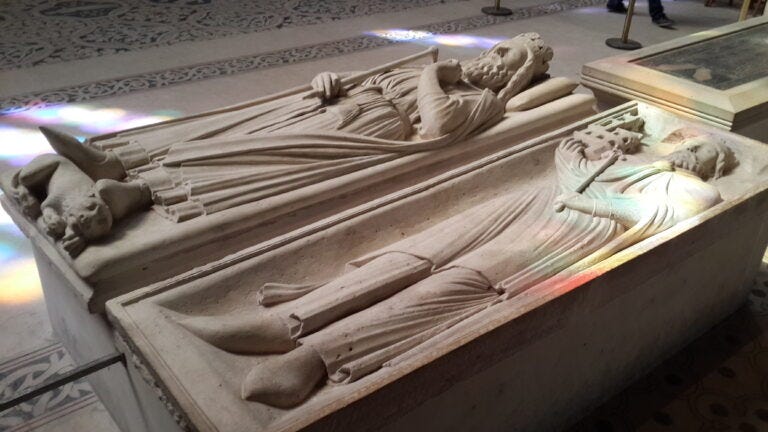The Salian Franks were a subgroup of an early Germanic tribe called the Franks who invaded the area of the Roman Empire called “Gaul”. Originally from the area now known as the Netherlands, by the time Clovis I became king in 481 at the death of his father, the Salian Franks had already founded the Merovingian kingdom (named after his grandfather) in what is now Belgium, northern France, the southern Netherlands, and the Rhineland part of Germany. See the darkest purple on the map below.
https://www.eupedia.com/forum/threads/is-france-a-misnomer.24350/
In 486, Clovis I and two of other allied Frankish kings faced off against Syagrius, the last governor of Roman Gaul, in the Battle of Soissons. Clovis was victorious; afterwards he turned on both of the other kings – his cousins, Ragnachar and Chararic – and seized their kingdoms as well.
Thus, by the end of the 486, Clovis had taken the cities of Rouen, Reims, and Paris as well as their surrounding areas. By 491, he had control of the entire west of France.
In 495, he was successful in defeating the Alemanni, a confederation of Germanic tribes in what is now southwestern Germany, at the Battle of Tolbiac. This particular battle was a turning point for the rise of Christianity in France.
The three panels comprising Le Voeu de Clovis à la Bataille de Tolbiac (The Vow of Clovis at the Battle of Tolbiac) by Joseph Blanc, the Panthéon, Paris, circa 1881
Although he had been raised a pagan, to ally with the powerful bishops in his kingdom and the overall Church, Clovis I married the Burgundian princess, Clotilde. She was a Nicene Christian and pushed for years for her husband to allow their children baptism and to convert. According to some scholars, by the time of the Battle of Tolbiac, Clovis realized that to help gain the allegiance of all the Franks he had subjugated and still meant to conquer, he should become a Christian. According to the chronicler Gregory of Tours, when Clovis I saw the vast numbers of his enemy at Tolbiac, he looked up towards the heavens and said:
“Jesus Christ, whom Clotilde declares to be the son of the living God, who it is said givest aid to the oppressed and victory to those who put their hope in thee, I beseech the glory of thy aid. If thou shalt grant me victory over these enemies and I test that power which people consecrated to thy name say they have proved concerning thee, I will believe in thee and be baptized in thy name. For I have called upon my gods, but, as I have proved, they are far removed from my aid. So I believe that they have no power, for they do not succor those who serve them. Now I call upon thee, and I long to believe in thee - all the more that may escape my enemies.”
After his victory, Clovis was baptized by the Bishop of Reims, which indeed helped to secure the loyalty of the provinces and kingdoms he subjugated. As a bonus, Clovis I’s baptism also earned him the recognition of the Byzantine Emperor, Anastasius.
The baptism of Clovis by Remy, Bishop of Reims, in a French manuscript dating 1375-1380.
With the support of his people and the Church, Clovis I continued to battle the Visigoths, whom he struggled against for his entire reign up until this point. He was finally successful against them when he won the Battle of Vouille (near what is now Poitier in western France) in 507. There he conquered Aquitania by defeating and killing the Visigoth king of Toulouse, Alaric II. After also conquering Angouleme and returning north, Clovis I was honored by Emperor Anastasius when he was made a Roman consul.
With the Visigoths finally defeated and his realm secure, Clovis returned to Paris to rule his united empire. He died there on November 27, 511 or 513, and was buried at the Church of St Genevieve, which he had founded. By the time of his death, he had greatly expanded the Merovingian empire (see all the purple in the map above). Although he was not the first Frankish king, he was likely the most successful. He is therefore known as the founder of modern France.
Effigy of Clovis I (top) next to one of his sons, Childebert, at Saint-Denis Basilica in Paris, France.
Sources for this post:
https://origin.web.fordham.edu/halsall/source/gregtours1.asp
https://www.eupedia.com/forum/threads/is-france-a-misnomer.24350/
https://www.britannica.com/biography/Clovis-I
https://www.worldhistory.org/Clovis_I/
http://www.historyofwar.org/articles/battles_soissons.html
http://www.historyofwar.org/articles/battles_tolbiac.html
http://www.historyofwar.org/articles/battles_vouille.html
https://godsandfoolishgrandeur.blogspot.com/2020/12/frenzy-and-prayer-le-voeu-de-clovis-la.html
https://urbrel.hypotheses.org/7506
https://commons.wikimedia.org/wiki/File:Bapt%C3%AAme_de_Clovis.jpg







